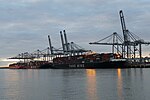Coryton Refinery

Coryton Refinery was an oil refinery in Essex, England, on the estuary of the River Thames 28 miles (45 km) from central London, between Shell Haven Creek and Hole Haven Creek, which separates Canvey Island from the mainland. It was a part of the Port of London and was the last of the three major refineries on the Thames Estuary to remain in operation, following closure of Shell Haven and BP Kent. Output was delivered by road, sea and rail, and it was linked to Stanlow Refinery in North West England by the UK Oil Pipeline (UKOP). There is a 753 MW gas-fired power station, opened in 2002 and run by Coryton Energy Co Ltd, part of Intergen. In January 2012, Petroplus filed for bankruptcy. Coryton Refinery ceased production in June 2012. The site is being turned into an industrial hub to be called Thames Enterprise Park.
Excerpt from the Wikipedia article Coryton Refinery (License: CC BY-SA 3.0, Authors, Images).Coryton Refinery
Thurrock
Geographical coordinates (GPS) Address External links Nearby Places Show on map
Geographical coordinates (GPS)
| Latitude | Longitude |
|---|---|
| N 51.513 ° | E 0.521 ° |
Address
Petroplus Coryton
Thurrock
England, United Kingdom
Open on Google Maps








